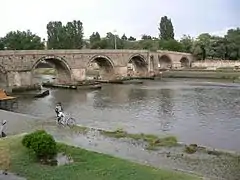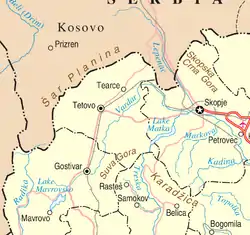Vardar
The Vardar (/ˈvɑːrdɑːr/; Macedonian: ⓘ, Albanian: Vardar/-i, Turkish: Vardar) or Axios (Greek: Αξιός, romanized: Aksiós, Albanian: Asi (historically)[1]) is the longest river in North Macedonia and a major river in Greece, in which it reaches the Aegean Sea at Thessaloniki.[2] It is 388 km (241 mi) long, out of which 76 km (47 mi) are in Greece,[2] and drains an area of around 25,000 km2 (9,653 sq mi). The maximum depth of the river is 4 m (13 ft).
| Vardar Вардар | |
|---|---|
 Vardar in Veles | |
| Native name |
|
| Location | |
| Countries | North Macedonia and Greece |
| Physical characteristics | |
| Source | |
| • location | Vrutok, near Gostivar |
| Mouth | |
• location | Aegean Sea, near Thessaloniki |
• coordinates | 40°30′27″N 22°43′3″E |
| Length | 388 km (241 mi) |
Etymology
The name Vardar for the river may derive from Thracian, though Paeonian and Ancient Macedonian were also spoken in lands drained by the river. In any case, Vardar is thought to derive from an earlier *Vardários, which may ultimately derive from Proto-Indo-European (PIE) *(s)wordo-wori- ("black water").[3][4] Vardar/Vardarios may be a translation of (or otherwise had a similar meaning as compared to) Axios, which itself may be Thracian and may have meant 'not-shining' from PIE *n.-sk(e)i (cf. Avestan axšaēna ("dark-coloured")).[5] This same hypothetical Thracian Axio- meaning “dark, not-shining” is theorized to be found in the name of a city at the mouth of the Danube, called Axiopolis in Greek and Axíopa (perhaps meaning "dark water") in Thracian, which may later have been translated into Slavic as Cernavodă (“black water”).[6] The name Vardários (Βαρδάριος) was sometimes used by the Ancient Greeks in the 3rd century BC. The same name was widely used in the Byzantine era.[6] The word may ultimately be derived from the PIE root werǵ-, which is also the source of the English work. Its name Axios is mentioned by Homer (Il. 21.141, Il. 2.849)[7] as the home of the Paeonians allies of Troy. Pjetër Bogdani would call it Asi, an earlier Albanian-language name for the river.[1]
Geography

The river rises at Vrutok, a few kilometers southwest of Gostivar in North Macedonia. It passes through Gostivar, Skopje and into Veles, crosses the Greek border near Gevgelija, Polykastro and Axioupoli ("town on the Axiós"), before emptying into the Aegean Sea in Central Macedonia, west of Thessaloniki in northern Greece.
The Vardar basin comprises two-thirds of the territory of North Macedonia. The valley features fertile lands in the Polog region, around Gevgelija and in the Thessaloniki regional unit. The river is surrounded by mountains elsewhere. The superhighways Greek National Road 1 in Greece and M1 and E75 run within the valley along the river's entire length to near Skopje.
The river was very famous during the Ottoman Empire and remains so in modern-day Turkey as the inspiration for many folk songs, of which the most famous is Vardar Ovasi. It has also been depicted on the coat of arms of Skopje, which in turn is incorporated in the city's flag.[8]
Project to construct the Danube-Vardar-Aegean Canal
A proposal to construct a canal connecting the Morava river valley with the Vardar, and hence linking the Danube to the Aegean Canal, has been a dream for a long time.[9] Le Figaro published a project of Athens and Belgrade on 28.08.2017. The Greek-Serbian proposal made in Beijing is Pharaonic: 651 km. A project worth 17 billion.[10]
Vardaris wind
The Vardaris or Vardarec is a powerful prevailing northerly ravine wind which blows across the river valley in Greece as well as in North Macedonia. At first it descends along the "canal" of the Vardar valley, usually as a breeze. When it encounters the high mountains that separate Greece from North Macedonia, it descends the other side, gathering a tremendous momentum and bringing cold conditions to the city of Thessaloniki and the Axios delta. Somewhat similar to the mistral wind of France, it occurs when atmospheric pressure over eastern Europe is higher than over the Aegean Sea, as is often the case in winter.
Gallery
 Map of the northwestern part of North Macedonia including the source of the Vardar
Map of the northwestern part of North Macedonia including the source of the Vardar Axios/Vardar river map
Axios/Vardar river map Veles Gorge
Veles Gorge.JPG.webp) River Vardar near Gradsko
River Vardar near Gradsko.JPG.webp) River Vardar near Gradsko (2)
River Vardar near Gradsko (2) Vardar (Axios) river in Greece
Vardar (Axios) river in Greece Longitudinal hidrographic profile of the flow of river Vardar
Longitudinal hidrographic profile of the flow of river Vardar
See also
References
- Arapi, Ina (17 December 2014). "Konferenca për Eposin e Kreshnikëve, Pjetër Bogdani dhe Dardania në gusht 2014 (rreth vendlindjes së arqipeshkvit Pjetër Bogdani)". Epoka e Re, Mittwoch, 17. 12. 2014. Mittwoch: 6.
- "The rivers – Axios Delta National Park". axiosdelta.gr. Retrieved 2020-08-05.
- Orel, Vladimir. A Handbook of Germanic Etymology. Leiden, Netherlands: Brill, 2003: 392.
- Mallory, J.P. and D.Q. Adams. Encyclopedia of Indo-European Culture. London: Fitzroy and Dearborn, 1997: 147
- Mallory, J.P. and D.Q. Adams. Encyclopedia of Indo-European Culture. London: Fitzroy and Dearborn, 1997, p. 146
- Katičic', Radoslav. Ancient Languages of the Balkans. Paris: Mouton, 1976: 149
- Axios, Georg Autenrieth, A Homeric Dictionary, at Perseus
- Official portal of the city of Skopje: City symbols Archived 2014-09-29 at the Wayback Machine. – Retrieved on 13 May 2009.
- The Project to Construct the Danube-Aegean Canal(2013)
- The Greek-Serbian proposal made in Beijing
External links
- Proceedings of the 1st Axios Catchment Consortium Meeting Archived 2011-07-22 at the Wayback Machine by the European Commission—DG Research
- PIM "Ivan Milutinović", Belgrade, Serbia; Morava - Vardar (Axios) Navigation Route—About 1,200 km shorter route (three days shorter time of navigation) from Belgrade to Port of Thessaloniki than across Danube, Black Sea and Aegean Sea. Electric power production, improvement of water quality and regulation of flooding wave.
- Morava—Vardar (Axios) Navigation Route map
- Hydropower and navigation system "Morava"—Concepts of regulation of rivers Great Morava and South Morava for navigation and hydropower production